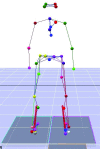KINEMATIC AND KINETIC VARIABLES DIFFER BETWEEN KETTLEBELL SWING STYLES
- PMID: 28593086
- PMCID: PMC5455182
KINEMATIC AND KINETIC VARIABLES DIFFER BETWEEN KETTLEBELL SWING STYLES
Abstract
Background: Kettlebell (KB) and indian club swings (ICS) are used diversely for developing strength and power. It has been proposed that multiple swing techniques can be used interchangeably to elicit similar adaptations within performance training. Hypothesis/Purpose: It was hypothesized that there will be not be a difference in peak joint angles between types of swings. Furthermore, given the nature of the overhead kettlebell swing (OKS), it was hypothesized that the OKS will be associated with a greater cycle time and a greater vertical impulse compared to shoulder height swing (SKS) and ICS. The purpose of this study was to analyze the kinematics and kinetics of the SKS, OKS, and ICS.
Study design: Cross-sectional cohort.
Methods: Fifteen healthy subjects underwent 3D biomechanical analysis for assessment of kinematic and kinetic data. Subjects performed two trials of ten repetitions at full effort for each swing in a randomized order using either a standard set of 0.45 kg indian clubs or sex specific KB loads (Female = 12kg, Male = 20kg). Lower extremity sagittal plane kinematics and kinetics were analyzed for peak values during the down and up portions of the swing patterns. Statistical analyses were carried out utilizing one-way ANOVAs (p<.05) and effect size indices.
Results: Cycle time for the OKS was 34% longer than the SKS and ICS (p<.001; ESISKS = 2.09, ESIICS=1.92). In general, ankle (SKS: 0.82 ± 0.16; OKS: 0.90 ± 0.21; ICS: 0.60 ± 0.15 BW*BH) and hip joint moments (SKS: 2.34 ± 0.68; OKS: 2.32 ± 0.53; ICS: 1.84 ± 0.47 BW*BH) and joint powers, along with peak vertical ground reaction forces (vGRF) (SKS: 0.98 ± 0.14; OKS: 0.96 ± 0.10; ICS: 0.86 ± 0.11 BW/s), were higher in the SKS and OKS than the ICS (p<.001; ankle: ESISKS/OKS=0.43, ESISKS/ICS=1.42; hip: ESISKS/OKS=0.03, ESISKS/ICS=0.87; vGRF: ESISKS/OKS=1.80, ESISKS/ICS=0.20). There were no observed differences found in peak joint angles between the movements.
Conclusion: Although these swings are kinematically similar, the differing kinetic demands of these exercises may be important in selecting the right training modality for specific strength and power training.
Level of evidence: 2.
Keywords: Kettlebell training; power; resistance training; strength.
Figures
References
-
- Hulsey CR Soto DT Koch AJ, et al. Comparison of kettlebell swings and treadmill running at equivalent rating of perceived exertion values. J Strength Cond Res. 2012;26(5):1203-7. - PubMed
-
- Lake JP Lauder MA. Kettlebell swing training improves maximal and explosive strength. J Strength Cond Res 2012; 26(8):2228-33. - PubMed
-
- Manocchia P Spierer DK Lufkin AK, et al. Transference of kettlebell training to strength, power, and endurance. J Strength Cond Res. 2013;27(2):477-84. - PubMed
-
- McKewon I Chapman DW Taylor K, et al. Time course of improvements in power characteristics in elite development netball players entering a full time training program. J Strength Cond Res. 2016;30(5):1308-15. - PubMed
-
- Otto WH 3rd Coburn JW Brown LE, et al. Effects of weightlifting vs. kettlebell training on vertical jump, strength, and body composition. J Strength Cond Res 2012;26(5):1199-202. - PubMed
LinkOut - more resources
Full Text Sources
Research Materials


